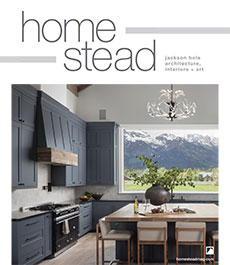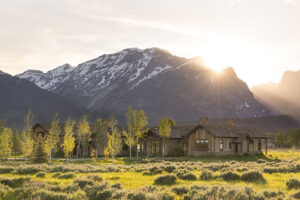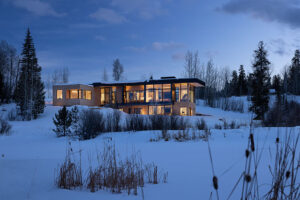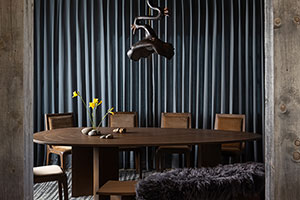+ Story by Richard Anderson
+ Photography by Cameron R. Neilson
INTERIOR DESIGNER
Snake River Interiors
snakeriverinteriors.com
Like the creek that winds through the 17-acre property, Andy and Elisa Chambers’ home off South Park Loop Road meanders gently through its pasture. A strand of water flows from the north, passes under the dining room and leads guests to a stately, well-proportioned portico and entryway done in Wyoming stone. The wood that clads much of the rest of the exterior comes from snow fences weathered to perfection by many a winter out on the high sage plains.

A thread of water, bringing to mind the irrigation ditches found throughout the surrounding ranchland, snakes under the dining room and flows into a pool that’s half decorative, half recreational.

Reclaimed timber and Arts and Crafts lanterns march along a wall of Wyoming stone, drawn by a glass-paneled door and the vision of the land beyond it.

Modern fixtures blend with antiques and Arts and Crafts furnishings throughout the home. The result is comfort, style and a superb sense of place.
Inside, the house has a natural current that carries visitors from chamber to chamber—like deep pools that invite one to stop and soak in the views—or deposits them in quiet corners. Nature grows right up to the very edges. At just under 5,000 square feet, the home is a tight, warm living space for the family of six—functional, yet aesthetic. The bulk of its glass faces south, welcoming in sunlight and the spectacular vistas of Munger Mountain and the Snake River gap down to Hoback. “The great thing about the south end of town is, you get the last glimpse of light falling on the valley,” says Elisa Chambers, who owns Snake River Interiors and the retail shop Twenty Two Home.

The expansive black walnut table was made by a friend in Idaho while the French glass-cloche light fixtures above were the owner-designer’s idea.

The art and furnishings reflect the owners’ long history of collecting.

Wyoming stone and reclaimed wood predominate through both the interior and exterior, for a raw yet refined look.
The mix of grand and intimate spaces showcases the family’s lifelong collection of exquisite works, a thoughtful mix of antiques, Arts and Crafts furnishings and contemporary style. The couple took their time developing their vision. They bought the property 15 years ago, but only began building six years ago. “We sat on different pieces of the property and imagined where each room would be and what we wanted to look out on from our bedroom,” Chambers says.

By eschewing the traditional stone hearth and chimney, the designer-builders were able to extend their expansive views south to Munger Mountain.
Shortly after they purchased the land, they came upon an old cabin in Cokeville, which they bought, disassembled and rebuilt on their property. That became the master bedroom while a second cabin became the children’s room. They linked the two structures with a chain of rooms—an office, a spacious living chamber, a generous dining room and a large but still cozy kitchen. “We don’t really have any hallways,” she says. Instead, one room opens onto the next, with only a few doors along the way to close off certain areas.

In the summer, the family can throw open the double doors for a nearly outdoor soak.

Dinner guests typically end up hanging out in the kitchen. No wonder, given its casual splendor and a spaciousness that does not compromise coziness.
Chambers, along with Snake River Interiors, does not confine herself to any one style: “We curate homes, we don’t decorate homes. You find pieces that speak to you and that you love. The juxtaposition between old and new is key to our design philosophy.” Texture and light, simplicity, balance and harmony are crucial. “The simplicity,” she points out, “allows you to appreciate your environment, not compete with it.”







